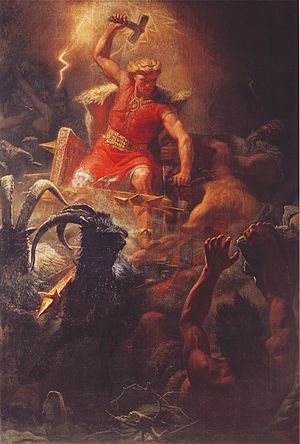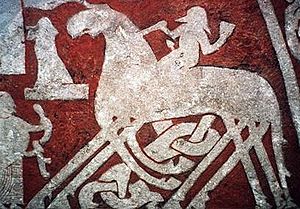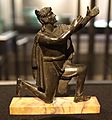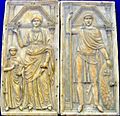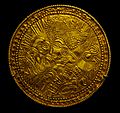Germanic peoples facts for kids
The Germanic peoples are a linguistic and ethnic branch of Indo-European peoples. They came from Northern Europe and are identified by their use of the Germanic languages. Migrating Germanic peoples spread throughout Europe, mixing with existing local populations (such as Celts, but also Slavs/Vends and Romans), forming the future basis of many nations, that are connected by similar languages and common history, and culture.
Latin Germani is first used by Julius Caesar.
But the Germanic tribes did not have a self name that included all Germanic-speaking people. In English, German is first attested in 1520, replacing earlier use of Almain or Dutch. Dutch is now used in the English language to refer to the language and the inhabitants of the Netherlands.
By the 1st century A.D., the writings of Caesar, Tacitus and other Roman era writers indicate a division of Germanic-speaking peoples into tribal groupings centred on:
- the rivers Oder and Vistula (Poland) (East Germanic tribes),
- the lower Rhine river (Istvaeones),
- the river Elbe (Irminones),
- Jutland and the Danish islands (Ingvaeones).
The Sons of Mannus Istvaeones, Irminones, and Ingvaeones are collectively called West Germanic tribes. In addition, those Germanic people who remained in Scandinavia are referred to as North Germanic. These groups all developed separate dialects, the basis for the differences among Germanic languages down to the present day.
The division of peoples into West Germanic, East Germanic, and North Germanic is a modern linguistic classification.
The Germanic tribes were each politically independent, under a hereditary king (see Germanic king). The kings appear to have claimed descendancy from mythical founders of the tribes, the name of some of which is preserved:
- Angul — Angles (the Kings of Mercia, according to the Anglo-Saxon Chronicle, other Anglo-Saxon dynasties are derived from other descendants of Woden)
- Aurvandil — Vandals (uncertain)
- Burgundus — Burgundians
- Cibidus — Cibidi
- Dan — Danes
- Nór — Norwegians
- Gothus — Goths
- Ingve — Ynglings
- Irmin — Irminones
- Longobardus — Lombards
- Saxneat — Saxons
- Valagothus — Valagoths
- Suiones — Swedes (Svear)
Contents
History
Origin

The early Germanic tribes spoke mutually intelligible dialects, and shared a common culture and mythology (see Germanic mythology), as is indicated by Beowulf and the Volsunga saga.
In the absence of large-scale political unification, such as that imposed forcibly by the Romans upon the peoples of Italy, the various tribes remained free, led by their own hereditary or chosen leaders.
Images for kids
-
Roman bronze statuette representing a Germanic man with his hair in a Suebian knot
-
The Roman province of Germania, in existence from 7 BCE to 9 CE. The dotted line represents the Limes Germanicus, the fortified border constructed following the final withdrawal of Roman forces from Germania.
-
A bog body, the Osterby Man, displaying the Suebian knot, a hairstyle which, according to Tacitus, was common among Germanic warriors.
-
Germanic kingdoms and peoples after the end of the Western Roman Empire in 476 CE
-
Frankish expansion from the early kingdom of Clovis I (481) to the divisions of Charlemagne's Empire (843/870)
-
The Sutton Hoo helmet from c. 625 in the British Museum.
-
Roughly carved wooden idols from Oberdorla moor, modern Thuringia. The idols were found in context with animal bones and other evidence of sacrificial rites.
-
Page from the Codex Argenteus containing the Gothic Bible translated by Wulfila.
-
The Istaby Stone (DR359) is a runestone that features a Proto-Norse Elder Futhark inscription describing three generations of men. Their names share the common element of 'wolf' (wulfaz) and alliterate.
-
Image of Romans fighting the Marcomanni on the Column of Marcus Aurelius (193 CE).
-
A 5th-century CE gold collar from Ålleberg, Sweden. It displays Germanic filigree work.
-
The Minerva Bowl, part of the Hildesheim Treasure, likely a Roman diplomatic gift. The treasure may date from the reign of Nero (37–68 CE) or the early Flavian dynasty (69–96 CE).
See also
 In Spanish: Pueblos germánicos para niños
In Spanish: Pueblos germánicos para niños


